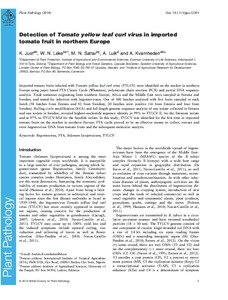| dc.contributor.author | Just, K. |
| dc.contributor.author | Leke, W. |
| dc.contributor.author | Sattar, M.N. |
| dc.contributor.author | Luik, A. |
| dc.contributor.author | Kvarnheden, A. |
| dc.date.accessioned | 2019-12-04T10:58:31Z |
| dc.date.available | 2019-12-04T10:58:31Z |
| dc.date.issued | 2014 |
| dc.identifier.citation | Just, K., Leke, W., Sattar, M.N., Luik, A. & Kvarnheden, A. (2014). Detection of tomato yellow leaf curl virus in imported tomato fruit in Northern Europe. Plant Pathology, 63(6), 1454-1460. |
| dc.identifier.issn | 0032-0862 |
| dc.identifier.uri | https://hdl.handle.net/20.500.12478/1009 |
| dc.description | Article first published online: 25 FEB 2014. Author(Leke, W.) present address is IITA indicated on the publication. |
| dc.description.abstract | Imported tomato fruits infected withTomato yellow leaf curl virus(TYLCV) were identified on the market in northernEurope using paper-based FTA Classic Cards (Whatman), polymerase chain reaction (PCR) and partial DNA sequenceanalysis. Trade tomatoes originating from southern Europe, Africa and the Middle East were sampled in Estonia andSweden, and tested for infection with begomoviruses. Out of 100 batches analysed with five fruits sampled in eachbatch (58 batches from Estonia and 42 from Sweden), 20 batches were positive (16 from Estonia and four fromSweden). Rolling circle amplification (RCA) and full-length genome sequence analysis of one isolate collected in Estoniaand one isolate in Sweden, revealed highest nucleotide sequence identity at 99% to TYLCV-IL for the Estonian isolateand at 97% to TYLCV-Mld for the Swedish isolate. In this study, TYLCV was identified for the first time in importedtomato fruits on the market in northern Europe. FTA cards proved to be an effective means to collect, extract andstore begomovirus DNA from tomato fruits and the subsequent molecular analysisImported tomato fruits infected withTomato yellow leaf curl virus(TYLCV) were identified on the market in northernEurope using paper-based FTA Classic Cards (Whatman), polymerase chain reaction (PCR) and partial DNA sequenceanalysis. Trade tomatoes originating from southern Europe, Africa and the Middle East were sampled in Estonia andSweden, and tested for infection with begomoviruses. Out of 100 batches analysed with five fruits sampled in eachbatch (58 batches from Estonia and 42 from Sweden), 20 batches were positive (16 from Estonia and four fromSweden). Rolling circle amplification (RCA) and full-length genome sequence analysis of one isolate collected in Estoniaand one isolate in Sweden, revealed highest nucleotide sequence identity at 99% to TYLCV-IL for the Estonian isolateand at 97% to TYLCV-Mld for the Swedish isolate. In this study, TYLCV was identified for the first time in importedtomato fruits on the market in northern Europe. FTA cards proved to be an effective means to collect, extract andstore begomovirus DNA from tomato fruits and the subsequent molecular analysis. |
| dc.format.extent | 001-007 |
| dc.language.iso | en |
| dc.subject | Solanum Lycopersicum |
| dc.subject | Tomato |
| dc.title | Detection of Tomato yellow leaf curl virus in imported tomato fruit in northern Europe |
| dc.type | Journal Article |
| dc.description.version | Peer Review |
| cg.contributor.affiliation | Estonian University of Life Sciences |
| cg.contributor.affiliation | Swedish University of Agricultural Sciences |
| cg.contributor.affiliation | International Institute of Tropical Agriculture |
| cg.contributor.affiliation | Institute of Agricultural Research for Development, Bamenda |
| cg.isijournal | ISI Journal |
| cg.authorship.types | CGIAR and advanced research institute |
| cg.iitasubject | Plant Diseases |
| cg.journal | Plant Pathology |
| cg.howpublished | Formally Published |
| cg.accessibilitystatus | Limited Access |
| local.dspaceid | 77938 |
| cg.identifier.doi | https://dx.doi.org/10.1111/ppa.12205 |

